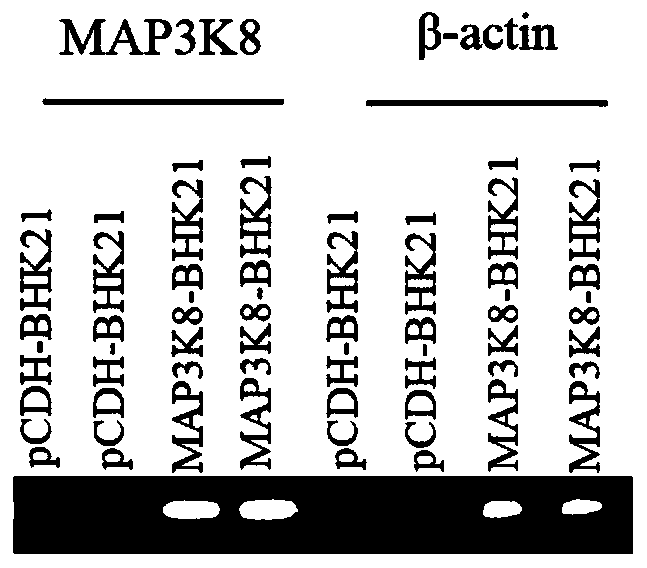Bhk-21 cell line stably expressing map3k8 protein and its construction and application
A BHK-21, stable expression technology, applied in BHK-21 cell line and its construction and application fields, can solve the problems of time-consuming and labor-intensive stable expression, and achieve the effect of improving virus yield and promoting virus replication.
- Summary
- Abstract
- Description
- Claims
- Application Information
AI Technical Summary
Problems solved by technology
Method used
Image
Examples
Embodiment 1
[0038] Example 1 Construction process of BHK-21 cell line BHK-21 / MAP3K8 stably expressing MAP3K8
[0039] 1.1 Construction of lentiviral vector and virus packaging
[0040] Specifically include the following steps:
[0041] Step 1: Construction of the recombinant lentiviral vector Lv-MAP3K8: Synthesize the CDS sequence of the Cricetulus griseus (Chinese hamster) MAP3K8 gene by chemical synthesis. The CDS sequence of the MAP3K8 gene refers to the sequence whose accession number is XM_007616553.2 on NCBI, and the CDS sequence of the MAP3K8 gene Recognition sites of Xba I and BamH I were introduced at the 5' end and 3' end of the DNA respectively, and the target gene and the lentiviral vector Lv-pCDH were digested with Xba I and BamH I, and then ligated to obtain the recombinant lentiviral vector Lv-MAP3K8 .
[0042] Step 2: Packaging lentivirus:
[0043] (1) Pack lentivirus Lv-pCDH and Lv-MAP3K8 virus liquids respectively with 293FT cells;
[0044] ① Digestion and inoculatio...
Embodiment 2
[0063] 2.1qRT-PCR verification cell line BHK-21 / MAP3K8 promotes FMDV replication
[0064] Include the following steps:
[0065] (1) Dilute the FMDV venom to a concentration of 1:500 with serum-free DMEM.
[0066] (2) Digest the BHK-21 / MAP3K8 cells and spread them on cell plates, and place them at 37°C, 5% CO 2 In the incubator, when the cells grow to 70%-90%, the cells are washed twice with serum-free DMEM to remove the residual serum in the cells.
[0067] (3) Add the diluted venom to the cells according to an appropriate volume (add 4ul of FMDV venom per 2ml of cell culture medium), and place at 37°C, 5% CO 2 After incubating in the incubator for 1 hour, the venom was discarded, replaced with 2% FBS DMEM maintenance solution, and the culture was continued. Samples were collected at 0, 12h, and 24h after inoculation.
[0068] (4) extract sample RNA and do reverse transcription, then carry out qRT-PCR, the primer (SEQ ID NO:7~8) of the 3D protein of used amplification FMDV...
Embodiment 3
[0084] 3.1qRT-PCR verification cell line BHK-21 / MAP3K8 promotes SVV replication
[0085] Include the following steps:
[0086] (1) Dilute SVV venom to a concentration of 1:500 with serum-free DMEM.
[0087] (2) Digest the BHK-21 / MAP3K8 cells and spread them on cell plates, and place them at 37°C, 5% CO 2 In the incubator, when the cells grow to 70%-90%, the cells are washed twice with serum-free DMEM to remove the residual serum in the cells.
[0088] (3) Add the diluted venom to the cells according to an appropriate volume (2ml of cell culture medium plus 4ul of SVV venom), and place at 37°C, 5% CO 2 After incubating in the incubator for 1 hour, the venom was discarded, replaced with 2% FBS DMEM maintenance solution, and the culture was continued. Samples were collected at 0, 12h, and 24h after inoculation.
[0089] (4) Extract sample RNA for reverse transcription, and then perform qRT-PCR. The absolute quantitative primers (SEQ ID NO: 9-10) used to amplify the conserved...
PUM
 Login to View More
Login to View More Abstract
Description
Claims
Application Information
 Login to View More
Login to View More - R&D
- Intellectual Property
- Life Sciences
- Materials
- Tech Scout
- Unparalleled Data Quality
- Higher Quality Content
- 60% Fewer Hallucinations
Browse by: Latest US Patents, China's latest patents, Technical Efficacy Thesaurus, Application Domain, Technology Topic, Popular Technical Reports.
© 2025 PatSnap. All rights reserved.Legal|Privacy policy|Modern Slavery Act Transparency Statement|Sitemap|About US| Contact US: help@patsnap.com



